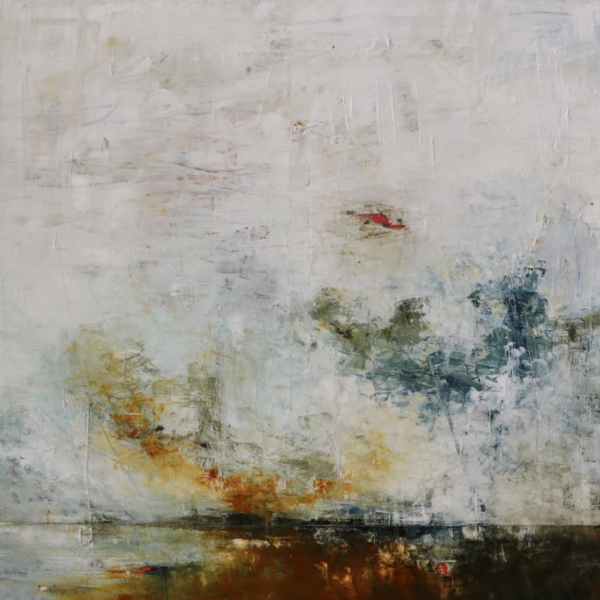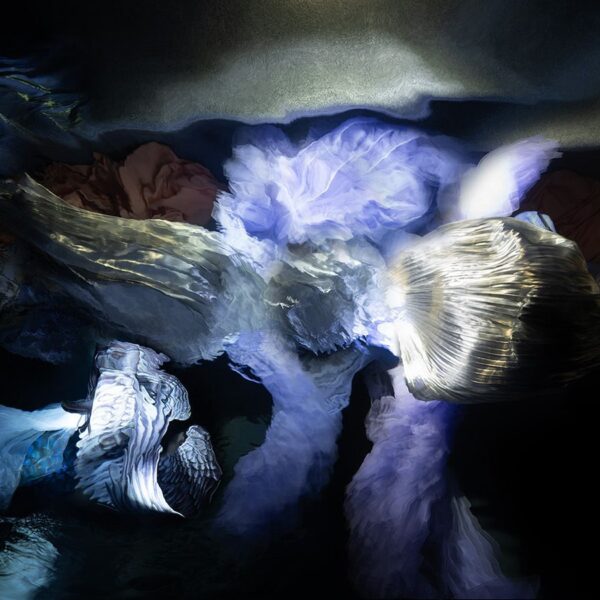LFW Preview: In Conversation with Hector Maclean
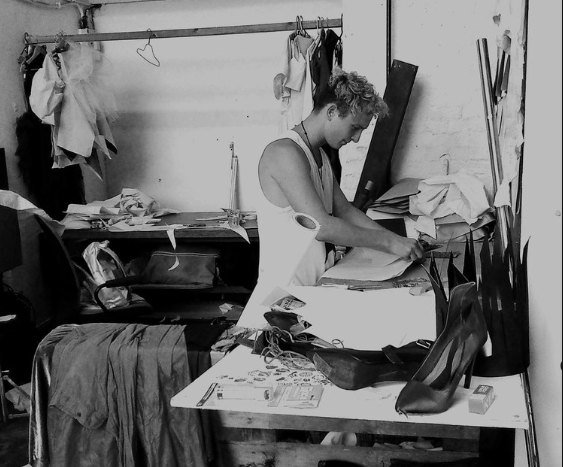
“Seeing the insanity in people and how it comes out in different forms of expression: each is art.”
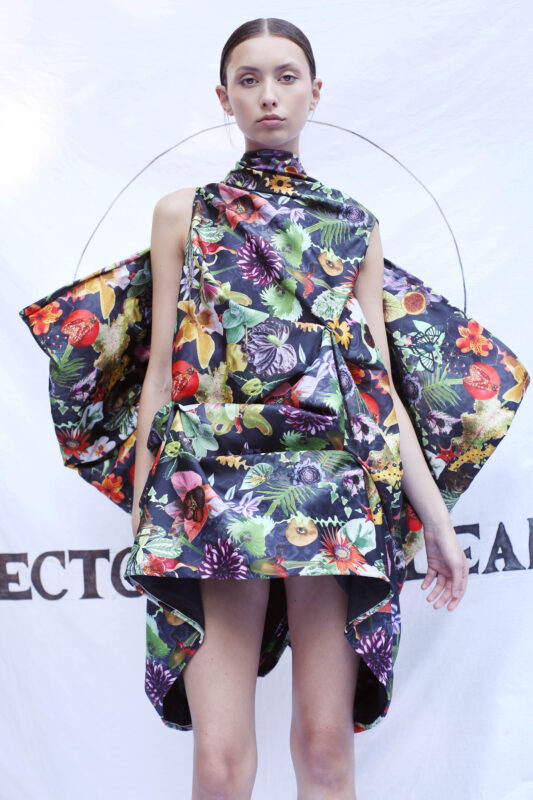
Hector Maclean is a storyteller, a provocateur, and a visionary who weaves narratives of rebellion, heritage, and radical beauty into his work.
His latest collection, BAstArd Aristocrat, is a striking exploration of contrasts—privilege and struggle, refinement and rawness, opulence and disorder—mirroring his own journey through fashion and identity. Drawing from literature, history, and the underground art scenes he has lived in, Maclean’s latest designs challenge the rigid class structures of Britain while celebrating the imperfections that makes us human.
Ahead of his London Fashion Week show, we talked to Maclean about the power of fashion as a form of social commentary, the art that fuels his creativity, and why, in his world, everyone deserves a crown.
The UK is a dichotomy – it’s people squatting in an abandoned Victorian mansion
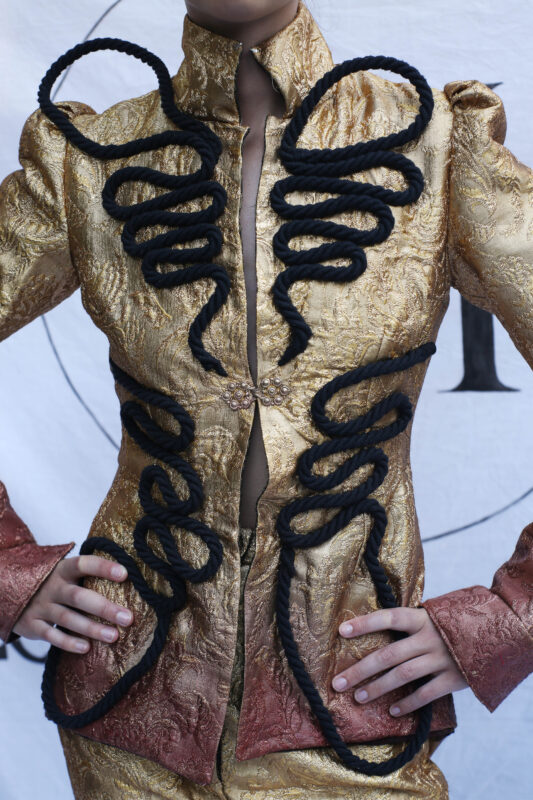
The name BAstArd Aristocrat, is an audacious contradiction in itself—a defiant mix of privilege and rebellion, refinement and destruction. “One of the phrases we have in the BAstArd Aristocrat collection is ‘posh and poor’, and I think personally throughout my life there’s always been a push and a pull from my accent versus not having much money growing up. People have always made presumptions about me in my life and immediately hate me, even though my incredible mother worked so hard to bring up four kids by herself.
That dichotomy of polarisation – there’s been a lot in my life, a lot of extreme contrasts and I think that’s so beautiful.”
This, he explains, is the energy that drives his work. The tension of extremes—the rawness of life set against the grandeur of history—sits at the core of his vision.
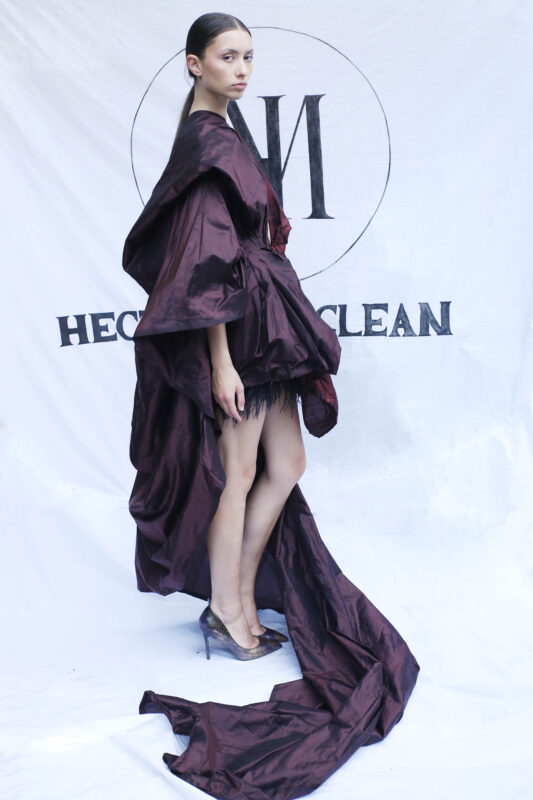
Maclean’s designs pull from a well of artistic influences that stretch far beyond fashion. Raised by a painter father and a dancer mother, he was immersed in creativity from the start, but it was the years spent living in warehouses with DJs, projection artists, and sculptors that shaped his sensibility. “Seeing the insanity in people and how it comes out in different forms of expression—that’s art,” he says. That chaotic, unrestricted artistic spirit bleeds into his collections. Each piece feels like a conversation between past and present, tradition and upheaval. He nods to the Pre-Raphaelites and British romanticism, but with a subversive edge—like a classic painting spray-painted over with neon.
His approach to fashion reflects this philosophy: beauty must be imperfect to be meaningful, and good art comes with contrast.
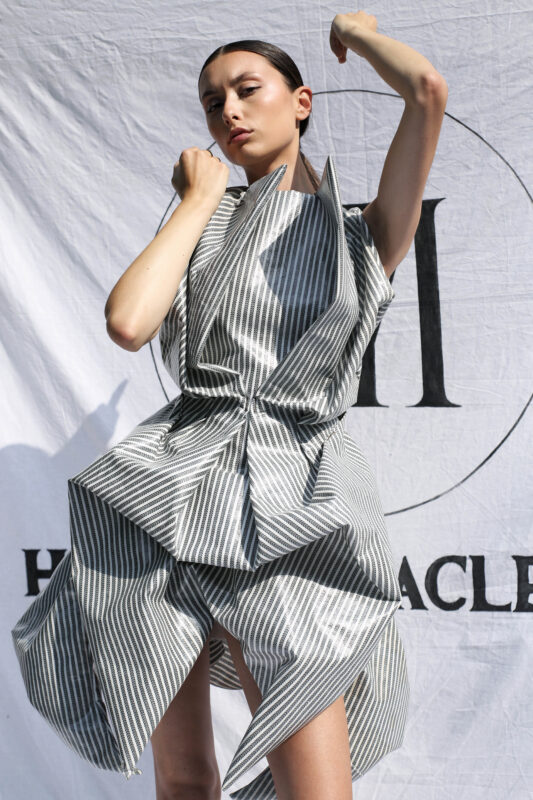
“Art without meaning is nothing, and that’s in reference to any form. In humanity, you can see when something is special is when someone’s heart and soul is in it, when it has meaning behind it. Then we all get behind it because we feel it. And that’s what I try to put across in my fashion – purpose. I’m trying to point out a class divider, and that we’re all one. I’m trying to point out that there’s poverty in the UK that we ignore. Subconsciously, we all want to be patriotic but it’s so hard to live in the UK right now. To drive this message, part of the collection is even made out of bed sheets!”
Life is about highs and lows and ups and downs; extremes either side and I think that’s what humanity is
Perhaps, at its heart, Maclean’s work is about power—not just who holds it, but who gets to wear it. “It’s annoying that it’s so expensive to manufacture clothing; I wish it could be available to absolutely everyone. We all deserve to feel grand. That’s the whole idea of the collection – we are all aristocratic in our own way; we are all princes and princesses, and I want people to feel like that.”
Maclean’s work has always often defined by stark contrasts—romance and radicalism, elegance and disorder—and BAstArd Aristocrat is no different. People have often made assumptions about him before they know the story, and this tension—the clash of expectation and reality—becomes part of his creative language. This powerfully translates into a respectful but rebellious consideration of beauty, as his ethos speaks to fearless women who wear their scars with pride.
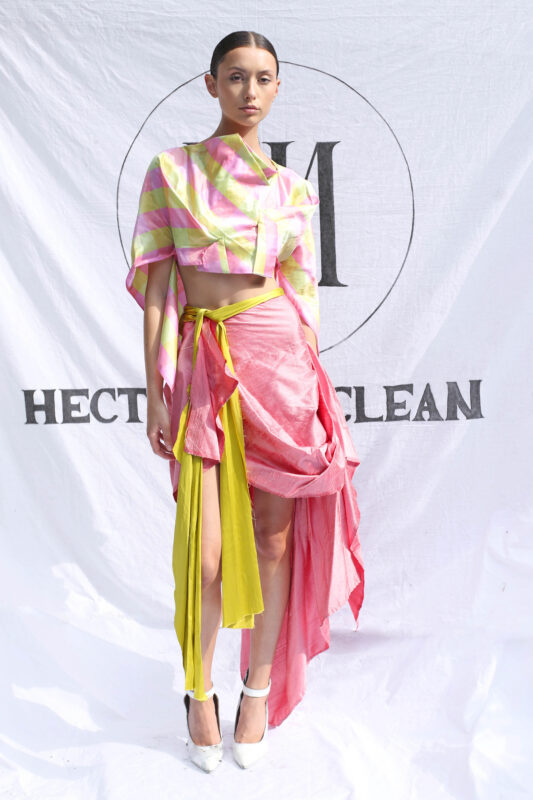
His collections celebrate fearless women, women who wear their scars with pride. “I want people to feel incredible when wearing Hector Maclean,” he says. “The best versions of themselves. There’s something insanely wonderful about women—they drive me to create.” His muses are strong, intelligent, ridiculous, unafraid. “I’m trying to uplift women who have said something powerful, who have made a statement.” His clothes are both armor and celebration, protection and exposure.
“I want people to feel incredible when wearing Hector Maclean,” he says. “I want people to feel the best versions of themselves and celebrate themselves. There’s something insanely wonderful about women, who drive me to create, and that’s the ethos of it all.
I love women, I respect women, and have such admiration. I’m trying to uplift intelligent women and make idols of female figures who have said something and said something powerful. My female protagonist is bolshy, she’s strong and immensely smart, yet playful, silly and ridiculous. I’m proud of my muses being themselves.”
BAstArd Aristocrat isn’t just a meditation on artistic and feminine contrasts—it’s also a critique of the rigid class structures that still define Britain. “We’re all one,” he says, of the absurdity of social divides. “We all belong, we’re all British, and we all need to end this class system, this pretentiousness.”
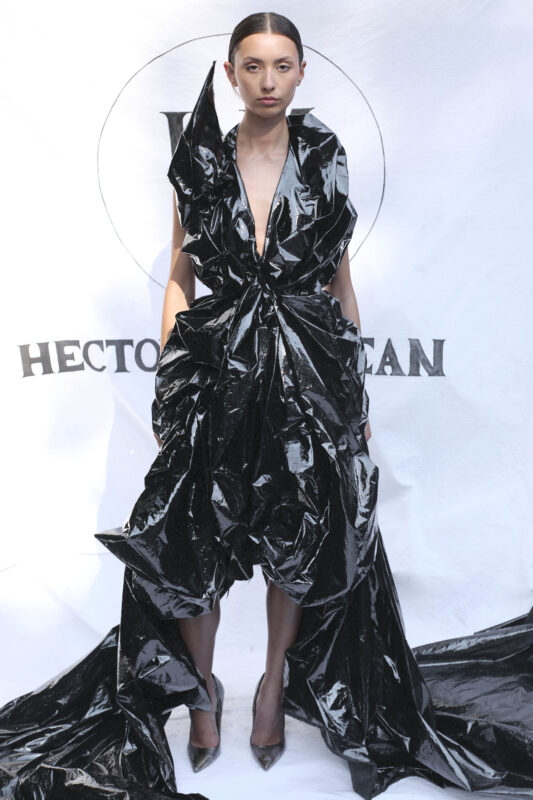
To drive the point home, Maclean recently paired Lidl trousers with a Haider Ackermann jacket. “I try to make a wearable grandeur. That’s a big idea behind my brand. I want it to feel earthy gritty and that everyone can wear it, but also grand and beautiful. We’re trying to style it in a fun way where we hope people can see themselves in the models and in the clothing.”
The collection isn’t just about aesthetic—it’s about statement. The UK, to Maclean, is a place where Kate Moss shops at Topshop in a Balenciaga jacket and where Lidl trousers can be paired with Haider Ackermann. It’s a world where class distinctions blur at the edges, and fashion, at its best, should reflect that.
I like to think that the brand sits in a pre-dimension where things are a little more anarchic, a little more unified and a little more loving. It’s a more raw and ready post-apocalyptic sci-fi world than my muse lives within. This collection is an otherworldly perspective, it’s anti-heritage with heritage, and trying to give it modernity and edge
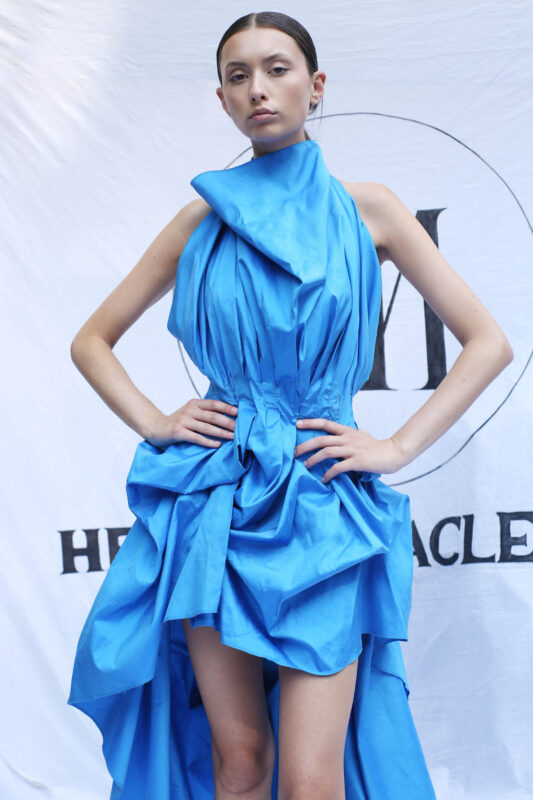
There’s also something deeply personal in this collection, an excavation of heritage that came as a revelation. “After last season, I was walking to a party thinking about what I wanted to say in my next collection,” he recalls. “Something a little more personal to me. My mum had brought up recently that we were aristocratic.”
The irony wasn’t lost on him—this juxtaposition of noble lineage and a tough upbringing. “I love that I’m this weird contradiction. It’s just all very real.” And that’s where BAstArd Aristocrat lives: in the messiness of reality, the friction between past and present, the collision of privilege and survival.
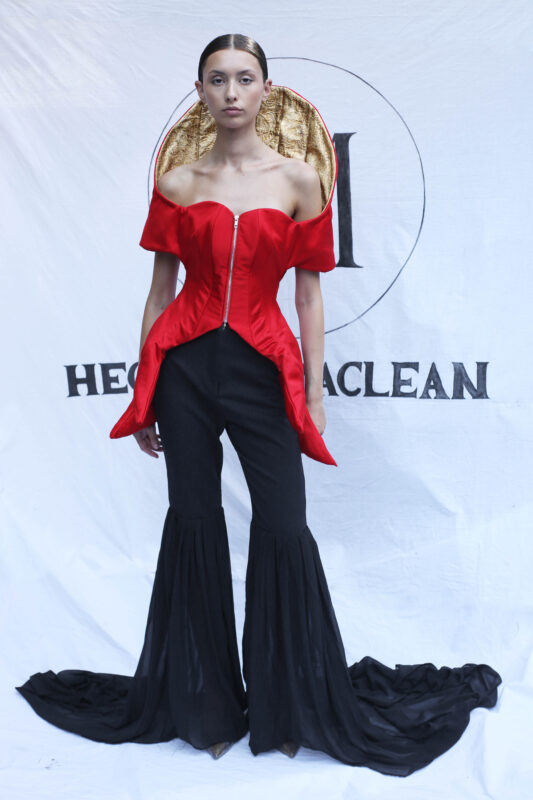
Despite its aristocratic undertones, the collection resists nostalgia. Maclean doesn’t romanticize the past—he fractures it, reshapes it, forces it into conversation with the now. “We’re lucky in the UK—we’re surrounded by beautiful architecture, and we just absorb it,” he muses. Even the most mundane places hold echoes of grandeur. “There’s a Wetherspoons in my hometown, and it’s the fanciest Wetherspoons you’ve ever seen. It’s like an old theatre oozing opulence, yet it’s a Wetherspoons. That high and low—I just love. It’s so real, so British.” He wants his designs to embody that same tension. “I want people to wear these gowns on bikes!” To be grand and gritty at once, to embrace contradiction as a way of life.
Asked to describe BAstArd Aristocrat in other artistic forms, Maclean pauses, then grins. “It would be a Brit-pop version of Mitski’s All American Girl. A Pre-Raphaelite painting spray-painted neon. A slightly renaissance, post-apocalyptic version of Pride & Prejudice. Or maybe Pride & Prejudice meets Threads.”
The comparison is apt. His work is a love letter to Britain, but one that acknowledges the cracks, the raw edges, the contradictions that make it what it is. It’s punk and aristocratic, opulent and makeshift, perfectly imperfect. It’s a world where anyone can be royalty, and that—above all—is the point.
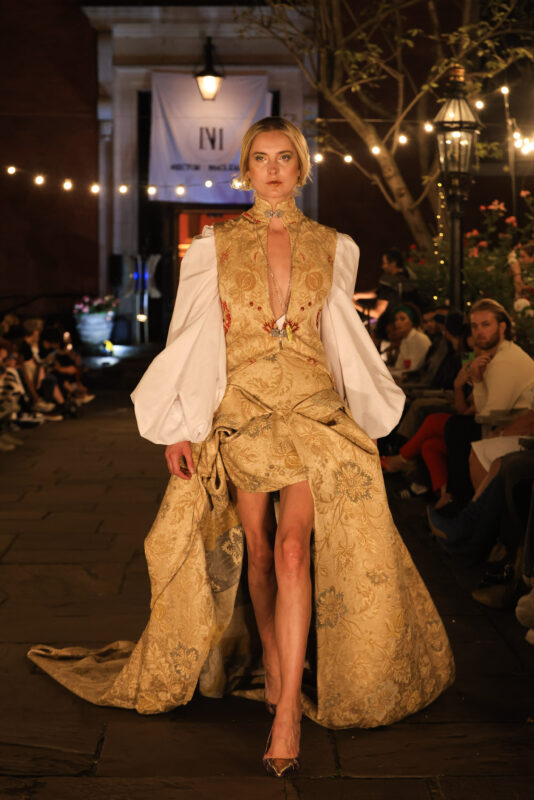
Hector Maclean SS24 (c) Alla Bogdanovic 101


